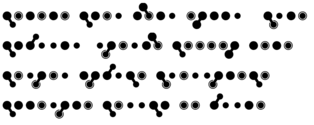Denobulan/Language
| Memory 118 |
|---|
| Memory 118 Guide • Full Index • A B C D E F G H I J K L M N O P Q R S T U V W X Y Z |
This notice was placed here by User:Pholin, so go bug them to finish the page if nothing's happening.
Denobulan (/də'noʊ.bju.læn/) is the primary language spoken by Denobulans along with Federation Standard. Most Denobulans who grew up on the planet speak both the languages. The language has been heavily influenced by Federation Standard since the planet's entry to the Federation; some Denobulans prefer speaking Standard, even among other Denobulans. However, as part of the Federation, the number of non-native speakers has grown significantly.
Disclaimer
The language was seen and heard on-screen, but the writers have confirmed that those words and sentences had no system or grammar. The version of the language delved into here is merely inspired by what was seen, but is more realistic. The two versions will be incompatible. Please reach out to User:Pholin before editing anything major.
Throughout this page, the International Phonetic Alphabet is used. For more information about that, please visit this article.
Phonology
For a non-linguistic summary of the phonology, click here.
Consonants
The following table shows the consonant phonemes of Denobulan:
| Consonants | Bilabial | Alveolar | Velar | Glottal |
|---|---|---|---|---|
| Plosive | p b | t d | k g | ʔ |
| Pre-nasalized pl. | ⁿd | ᵑg | ||
| Affricates | t͡s | |||
| Nasal | m | n | ŋ | |
| Fricative | ɸ | s | h | |
| Approximant | β̞ | ɹ | j | |
| Lateral appr. | l |
If there are two consonants in one cell, the left one is voiceless and the right one voiced.
Notes
- Unlike Federation Standard, Denobulan doesn't aspirize its voiceless plosives. However, in some non-native dialects aspirization can be found.
- The glottal plosive is only placed between two of the same vowel phones.
- The pre-nasalized plosives [ⁿd] and [ᵑg] are relics of Denobulan's proto-language and can only be found word-initially nowadays. Second language speakers often struggle pronouncing these two phonemes.
- The affricate [t͡s] is often pronounced as the palato-alveolar affricate [t͡ʃ] or sometimes [d͡ʒ] due to Federation Standard influences.
- There are no voiced fricatives in Denobulan, although most speakers pronounce fricatives between two vowels as voiced phonemes, which are written phonetically as [β], [z] and [ɦ].
- The bilabial fricative [ɸ] sounds like Federation Standard's [f] but does not include the lower teeth touching the upper lip.
- The bilabial approximant [β̞] sounds like Federation Standard's [w] but does not include pushing the tongue back to the velar.
- The lateral approximant [l] never velarizes, unlike in Federation Standard (compare "lab" and "ball", the latter is velarized).
Vowels
There are eight vowels in Denobulan. The language also distinguishes some vowels by length. Long vowels are spoken for a longer amount of time. The language has no diphthongs. The following table shows the vowel phonemes of Denobulan:
| Vowels | Front | Back |
|---|---|---|
| High | i iː | u uː |
| Mid | ɛ e | ɔ |
| Low | ä | |
If there are two vowels in one cell, the left one is short and the right one long.
Notes
- The short high front vowel [i] loses its quality and becomes [ɪ] in some dialects.
- The vowels /i/ and /u/ are distinguished by length grammatically; even though there is a slight difference in length between [ɛ] and [e], these are two distinct vowels not grammatically distinguished by length.
- The mid back vowel [ɔ] becomes the schwa [ə] when unstressed.
- The low vowel [ä] can be realized in multiple ways.
- Some dialects distinguish short [ɑ] and long [ä]; this is non-standard, however, it is prevalent in some words adopted into the common language.
- In other dialects, it might be pronounced as [a], [ɐ] or [ɑ].
- Vowels will be nasalized slightly when succeeded by nasal consonants. The nasal consonants are still pronounced.
